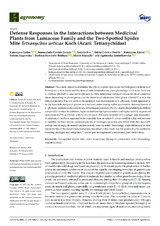Mostrar el registro sencillo del ítem
Defense Responses in the Interactions between Medicinal Plants from Lamiaceae Family and the Two-Spotted Spider Mite Tetranychus urticae Koch (Acari: Tetranychidae)
| dc.contributor.author | Golan, Katarzyna | |
| dc.contributor.author | Garrido-Jurado, Inmaculada | |
| dc.contributor.author | Kot, Izabela | |
| dc.contributor.author | Górska-Drabik, Edyta | |
| dc.contributor.author | Kmieć, Katarzyna | |
| dc.contributor.author | Łagowska, Bożena | |
| dc.contributor.author | Skwaryło-Bednarz, Barbara | |
| dc.contributor.author | Kopacki, Marek | |
| dc.contributor.author | Jamiołkowska, Agnieszka | |
| dc.date.accessioned | 2021-03-02T08:53:31Z | |
| dc.date.available | 2021-03-02T08:53:31Z | |
| dc.date.issued | 2021 | |
| dc.identifier.uri | http://hdl.handle.net/10396/21103 | |
| dc.description.abstract | This study aimed to determine the effects of plant species on the biological parameters of Tetranychus urticae Koch and the time of mite infestation on plant physiology in Ocimum basilicum L., Melissa officinalis L. and Salvia officinalis L. Mite infestation induced various levels of oxidative stress depending on plant species and the duration of infestation. Host plants affected T. urticae life table parameters. The low level of susceptibility was characteristic of S. officinalis, which appeared to be the least infected plant species and reduced mites demographic parameters. Infested leaves of S. officinalis contained elevated levels of hydrogen peroxide (H2O2) and malondialdehyde (MDA) compared to control. In addition, higher membrane lipid peroxidation and higher activity of guaiacol peroxidase (GPX) and lower activity of catalase (CAT) were recorded with a longer mite infestation. In contrast, O. basilicum appeared to be a suitable host on which T. urticae could develop and increase in number. In basil leaves, increasing levels of hydrogen peroxide and MDA with elevated GPX activity and strongly decreased catalase activity were recorded. Knowledge of the differences in mite susceptibility of the tested medicinal plants described in this study has the potential to be applied in breeding strategies and integrated T. urticae pest management in medicinal plant cultivations. | es_ES |
| dc.format.mimetype | application/pdf | es_ES |
| dc.language.iso | eng | es_ES |
| dc.publisher | MDPI | es_ES |
| dc.rights | https://creativecommons.org/licenses/by/4.0/ | es_ES |
| dc.source | Agronomy 11(3), 438 (2021) | es_ES |
| dc.subject | Two-spotted spider mite | es_ES |
| dc.subject | Plant acceptance | es_ES |
| dc.subject | Biological parameters | es_ES |
| dc.subject | Plant physiology | es_ES |
| dc.subject | Oxidative stress | es_ES |
| dc.title | Defense Responses in the Interactions between Medicinal Plants from Lamiaceae Family and the Two-Spotted Spider Mite Tetranychus urticae Koch (Acari: Tetranychidae) | es_ES |
| dc.type | info:eu-repo/semantics/article | es_ES |
| dc.relation.publisherversion | http://dx.doi.org/10.3390/agronomy11030438 | es_ES |
| dc.rights.accessRights | info:eu-repo/semantics/openAccess | es_ES |

